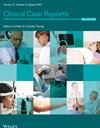具有相同临床病理特征的皮肤假性淋巴瘤,由蜱虫叮咬在两个不同的部位引起。
IF 0.6
Q3 MEDICINE, GENERAL & INTERNAL
引用次数: 0
摘要
在两个不同的蜱虫叮咬部位的相同皮肤镜和组织病理学检查结果表明,在单个皮肤假性淋巴瘤患者中存在典型的免疫反应,诊断线索包括保留的水泥锥和白色网状线,即使没有可见的蜱虫部位。本文章由计算机程序翻译,如有差异,请以英文原文为准。






Cutaneous Pseudolymphomas With Identical Clinicopathological Features Induced by Tick Bites at Two Separate Sites.
Identical dermoscopic and histopathologic findings at two distinct tick bite sites demonstrate a stereotypical immune response within a single individual of cutaneous pseudolymphoma, with diagnostic clues including retained cement cones and white reticular lines, even in the absence of visible tick parts.
求助全文
通过发布文献求助,成功后即可免费获取论文全文。
去求助
来源期刊

Clinical Case Reports
MEDICINE, GENERAL & INTERNAL-
自引率
14.30%
发文量
1268
审稿时长
13 weeks
期刊介绍:
Clinical Case Reports is different from other case report journals. Our aim is to directly improve global health and increase clinical understanding using case reports to convey important best practice information. We welcome case reports from all areas of Medicine, Nursing, Dentistry, and Veterinary Science and may include: -Any clinical case or procedure which illustrates an important best practice teaching message -Any clinical case or procedure which illustrates the appropriate use of an important clinical guideline or systematic review. As well as: -The management of novel or very uncommon diseases -A common disease presenting in an uncommon way -An uncommon disease masquerading as something more common -Cases which expand understanding of disease pathogenesis -Cases where the teaching point is based on an error -Cases which allow us to re-think established medical lore -Unreported adverse effects of interventions (drug, procedural, or other).
 求助内容:
求助内容: 应助结果提醒方式:
应助结果提醒方式:


